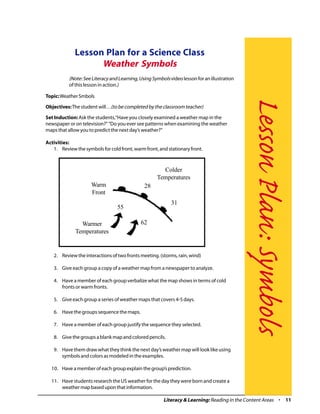
Lssn 3wsym
- 1. Lesson Plan for a Science Class Weather Symbols (Note: See Literacy and Learning, Using Symbols video lesson for an illustration of this lesson in action.) Topic: Weather Smbols Lesson Plan: Symbols Objectives: The student will…(to be completed by the classroom teacher) Set Induction: Ask the students,“Have you closely examined a weather map in the newspaper or on television?” “Do you ever see patterns when examining the weather maps that allow you to predict the next day’s weather?” Activities: 1. Review the symbols for cold front, warm front, and stationary front. Colder Temperatures Warm 28 Front 31 55 Warmer 62 Temperatures 2. Review the interactions of two fronts meeting. (storms, rain, wind) 3. Give each group a copy of a weather map from a newspaper to analyze. 4. Have a member of each group verbalize what the map shows in terms of cold fronts or warm fronts. 5. Give each group a series of weather maps that covers 4-5 days. 6. Have the groups sequence the maps. 7. Have a member of each group justify the sequence they selected. 8. Give the groups a blank map and colored pencils. 9. Have them draw what they think the next day’s weather map will look like using symbols and colors as modeled in the examples. 10. Have a member of each group explain the group’s prediction. 11. Have students research the US weather for the day they were born and create a weather map based upon that information. Literacy & Learning: Reading in the Content Areas • 11
- 2. Closure: Prepare a bulletin board display of each group’s sequence maps and prediction maps. Display the weather-on-your-birthday maps. Evaluation Suggestions: Check understanding of map symbols and the passage of fronts. Check the completeness of the prediction maps and birthday maps. Check the prediction against actual events. Resources and Materials: A 4-5 day sequence of weather maps from a newspaper, blank US maps, colored pencils. Library or Internet access for birthday weather research. Other Applications Other symbols can be incorporated into the above lesson, such as stationary and occluded fronts, as well as the various symbols for precipitation, wind direction, and Reaction Guide storms. The teacher may want to include lessons from other content areas that require the use of symbols for understanding of the material (such as map symbols, charts, numerical symbols, etc.) The class can explore the use of symbols in everyday life and what those symbols mean to them in terms of information, regulation, safety, etc. Reaction Guide Agree Disagree 1. Literacy competencies involve a student’s interaction with written text. 2. Symbols provide instant recognition of information that could be very dense in written form. 3. Symbols are helpful for students who have difficulty reading and comprehending written material. Literacy & Learning: Reading in the Content Areas • 12